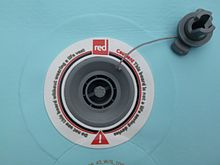I-SUP
The term I-SUP is an acronym consisting of the English word 'Inflatable' and the surfing sport Stand Up Paddling (SUP). It is a collective term for inflatable stand-up boards and is also used by some brand manufacturers under the name Air SUP or iSUP Board .
Construction and processing
Classic SUP boards, like surfboards, are made of epoxy resin and are rigid. Therefore, alternatives were sought, such as how to simplify the transport and storage of the relatively bulky boards while still guaranteeing sufficient dimensional stability, which is not the case with normal inflatable boats .
The dropstitch construction developed in Korea paved the way for inflatable SUP boards that are dimensionally stable. The principle of the drop stitch construction is based on connecting the top and bottom insides of the board with vertical connecting fibers and keeping them in the desired shape even under high internal pressure. The result is a fabric that is very tear-resistant and dimensionally stable due to the large number of knots and can withstand particularly high loads, but can still be folded up compactly when not inflated. Modern SUP boards with a drop stitch core allow an internal pressure of 15 to 25 psi . Depending on the manufacturer, different layers of dropstitch fabric are glued and vulcanized with PVC of different qualities . The top is usually covered with a deck pad made of EVA to offer the stand-up paddler more slip resistance on the board. I-SUP boards are characterized by a small round bulge on the underside of the board at the level of the valve, which sometimes leads to concerns about durability and processing quality among water sports enthusiasts. However, this bulge is due to technical reasons, since no dropstitch fabric can be used at the level of the valve.
Board types
The division of the I-SUP boards into board types follows the classification of the rigid, non-inflatable boards: The long-distance boards such as touring and race SUP boards are more streamlined and reach thanks to their narrowness and their pointed bugs and stern thus a better directional stability and higher top speeds. Pure wave SUP boards, on the other hand, are wider and cut shorter in order to ensure better wave yield and better stability. All-round boards with a curved bow and medium width are usually a compromise between these two board types, which are designed for the widest possible range of uses.
Effect of board thickness
The thickness of the boards is 4 inches (about 10 cm) and 6 inches (about 15 cm) common in the market. The thicker boards offer more buoyancy and more surfing comfort with a larger volume. In addition, they are stiffer, but less easy to turn. For this reason, the thicker board with the greater directional stability is traditionally used for touring and fitness boards as well as in the racing sector, while the 4-inch board is more standard in waves.
Comparison with conventional SUP boards
The I-SUP has compact packing dimensions, is relatively light and yet robust. It can be transported in the trunk or on the bike rack and stored to save space. A disadvantage is that, in terms of performance, a rigid board made of epoxy construction is somewhat inferior: the slightly lower rigidity can result in warping of the board body, which affects the streamlining and the speed. However, as the air pressure increases, the likelihood of this effect decreases rapidly.
literature
- Erbe, Andreas: SUP - The Stand-Up Paddling Bookazine . Delius Klasing Verlag GmbH, Bielefeld 2013, ISBN 978-3768836685 .
See also
Web links
- I-SUP boards from Mistral am Ammersee
- Reporting and video about the German Indoor I-Sup Championship at the boot fair 2014 in Düsseldorf


